From a garden you just “look at” to one you truly experience.
The three-dimensional Gyokuseninmaru Garden—rising 22 meters from pond to parapet—along with Gyokusen-an where you can savor matcha, the striking black namako-plastered Nezumitamon Gate & Nezumitamon Bridge, the stonework showcase of the Rikō Turret Platform, and the former front entrance of the castle at the Ōtemon Gate Ruins & Kuromon. On this page, you can tour these West Bailey (Nishi-kuruwa) highlights all at once via 360° panoramas and immerse yourself in the layered “depth” of Kanazawa Castle woven by light, water, and stone.
West Bailey & Outer Bailey
Gyokuseninmaru Garden (Gyokuseninmaru Teien)
⭐ Recommendation
Historical Significance: ☆☆
Visual Appeal: ☆☆☆
Experiential Value: ☆☆
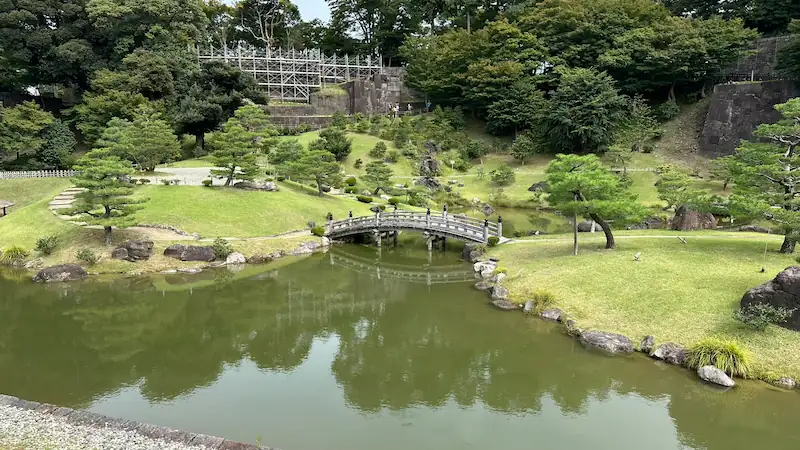
Gyokuseninmaru Garden is a daimyo garden that once stood in the castle’s western bailey known as “Gyokuseninmaru.” Based on excavations and historical sources from the Heisei era, it was restored and opened to the public in March 2015. From the early 1600s (the Kan’ei era) onward, successive lords of the Maeda clan of Kaga admired this space. Its hallmark is a sculptural, multi-layered composition where castle architecture, garden design, and stone walls fuse into one.
This is a strolling pond garden (chisen kaiyū-shiki) fed by Tatsumi Waterway, which runs through Kanazawa Castle. The vertical difference from the pond bed to the top of the highest stone wall is about 22 meters. Waterfalls and streams are integrated into the garden’s fabric, and the shikishi-tanzaku-zumi stonework (a “paper-card & poem-slip” pattern of stacked stones) functions as a deliberate design element. Walking paths loop through the garden so you can wander at an easy pace and enjoy changing views at every turn.
The garden also features a tearoom and rest space called Gyokusen-an, where you can relax while gazing out at the scenery. A matcha with traditional confection set is offered (about ¥730). Tea service runs from 9:00 a.m. to 4:30 p.m., and the interior is designed to harmonize with the garden.
Panorama
| Opening (Restoration) | March, Heisei 27 (2015) |
|---|---|
| Garden Style | Strolling pond garden (chisen kaiyū-shiki) |
| Elevation Change | Approx. 22 m from pond bed to top of the stone wall |
| Main Features | Waterfalls & streams, shikishi-tanzaku stacked stone walls, ornamental stones, artificial hills, pond islands, walking paths |
| Rest Facility | Gyokusen-an (matcha & wagashi available) |
| Admission | Free (garden area) |
| Hours | Mar 1–Oct 15: 7:00–18:00 Oct 16–end of Feb: 8:00–17:00 |
| Cultural Status | Part of the nationally designated Historic Site “Kanazawa Castle Ruins” |
🗺 Address: 1-1 Marunouchi, Kanazawa, Ishikawa (inside Kanazawa Castle Park)
🚶 Access
About a 7-minute (approx. 500 m) walk from the Tsuru-no-Maru Rest House.
⏳ Time Needed
Highlights in a hurry: about 5 minutes
Leisurely visit: about 30 minutes (garden layout, stonework design, notable plantings, plus a rest)
📍 Highlights
- Shikishi-tanzaku stonework: A mix of straight and curved alignments; the stone wall itself becomes an ornamental design element.
- Waterfalls and flowing water: A composition that channels water from the source, creating scenery that changes with time and light.
- Pond, islands, and paths: See hills and islets across the water; as you stroll, new perspectives unfold.
- Borrowed scenery: Stone walls and the Sanjūkken Nagaya (Longhouse) behind the garden are framed as shakkei, sharpening the overall composition.
- Nighttime lighting: After dark, the garden becomes a “fantastical space,” with lighting that shifts every seven minutes.
📌 Trivia
- Name origin: One theory links “Gyokuseninmaru” to Eihime—Oda Nobunaga’s fourth daughter and wife of the 2nd Kaga lord Maeda Toshinaga—who, after taking the tonsure, was known as “Gyokusen-in” and maintained a residence here.
- Lost and reborn: The garden disappeared after the Meiji period, but excavated remains and historical drawings enabled its modern restoration—reviving a long-lost landscape.
- “Stone Wall Museum” vision: The garden’s layered stonework has such intricate artistry that it’s often praised as a museum of stone walls in its own right.
- Shifting night scenes: The lighting cycles through three moods—sunset, dusk, and moonlit—offering different expressions depending on when you visit.
- Older than Kenrokuen?: Its origins are traced to around 1634 (Kan’ei 11), which some consider earlier than the formation of Kenrokuen Garden.
Gyokusen-an (Gyokusen-an)
⭐ Recommendation
Historical Significance: ☆☆
Visual Appeal: ☆☆☆
Experiential Value: ☆☆
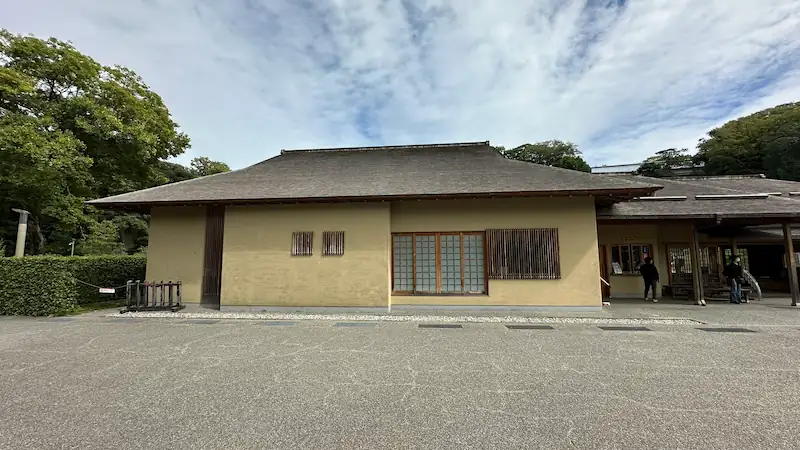
Gyokusen-an is a tearoom and rest house set within Gyokuseninmaru Garden, offering one of the best vantage points over the scenery. In the Edo period, this site housed the “Roji-yakusho,” an office responsible for garden maintenance and improvements; the current facility stands on its remains. From inside, you can take in the artful stonework—especially the shikishi-tanzaku pattern—composed with the garden as borrowed scenery, and enjoy a quiet moment.
| Structure | Single-story timber; shingle roof; footprint approx. 226 m² |
|---|---|
| Rooms | Lounge, information desk, Japanese rooms (tearooms) 12 tatami & 8 tatami, mizuya (prep room), veranda corridor, entrance, waiting area |
| Tea Service Hours | 9:00–16:30 (last entry 16:00). *Closed to entry at times between 12:00–13:00 for cleaning. |
| Tea Service Fee | Matcha + original jōnamagashi confection set: ¥730 |
| Closed | Year-end/New Year holidays (Dec 29–Jan 3) |
🗺 Address: 1-1 Marunouchi, Kanazawa, Ishikawa (inside Gyokuseninmaru Garden)
🚶 Access
About a 2-minute walk along the Gyokuseninmaru Garden path.
⏳ Time Needed
If you’re settling in with matcha: about 15 minutes
📍 Highlights & Tips
- Harmony with borrowed scenery: Windows frame the garden’s waterfalls, stone walls, and pond, creating a seamless connection between tea and view.
- Matcha with seasonal sweets: A classic pairing of local wagashi and matcha—an experience of “garden & tea.”
- Available for private tea gatherings: The facility can be reserved for tea ceremonies and events.
- Nighttime lighting: On weekend evenings, the garden and stone walls are illuminated for a dreamlike atmosphere.
- A site layered with meaning: Rebuilt on the former Roji-yakusho grounds, it bridges historic garden management and a contemporary visitor experience.
Nezumitamon Gate (Nezumitamon) & Nezumitamon Bridge
⭐ Recommendation
Historical Significance: ☆☆
Visual Appeal: ☆☆☆
Experiential Value: ☆☆☆
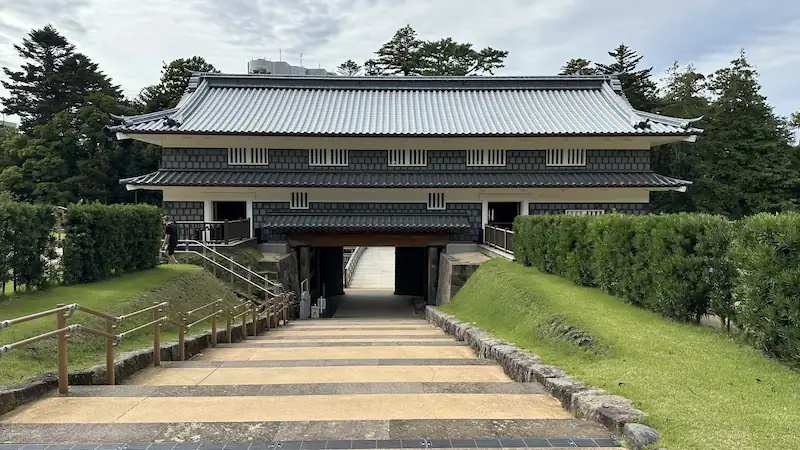
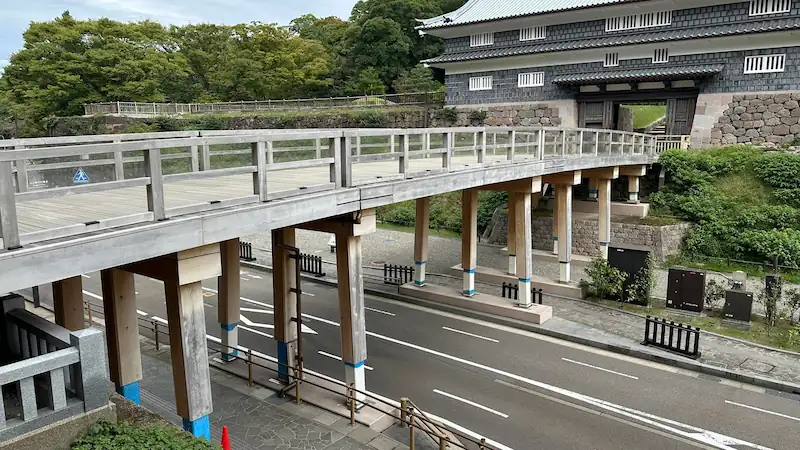
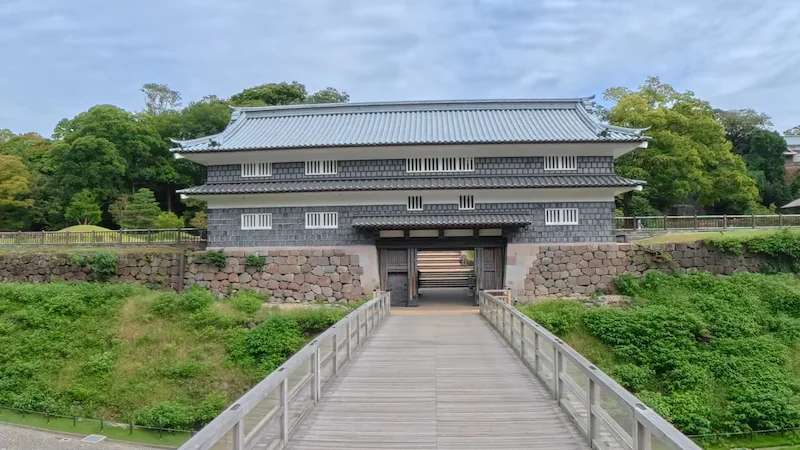
Nezumitamon is a two-story turret gate on the castle’s west side (the Gyokuseninmaru side). It once functioned as an entrance connected by the Nezumitamon Bridge linking the Kanaya Demaru (around today’s Oyama Shrine) to Gyokuseninmaru. The gate is believed to have existed by the early Edo period. Although it survived the great fire of 1759 (Hōreki 9), it later burned and the bridge was dismantled in the Meiji era, disappearing from view for well over a century.
Following surveys and a restoration plan launched in 2014 (Heisei 26), Nezumitamon Gate and Nezumitamon Bridge were reconstructed in July 2020 (Reiwa 2), returning after roughly 140 years. The gate’s exterior features distinctive namako plasterwork with black joints—a unique look among Kanazawa Castle’s gates. The bridge, the largest wooden-style bridge within the castle grounds, pairs a timber exterior with concealed steel members for earthquake resilience.
Panoramas
| Reconstruction Completed | July 18, Reiwa 2 (2020) |
|---|---|
| Structure & Features | Two-story turret gate; lead tiles on the roof; white plaster & namako walls with black-jointed mortar |
| Bridge Scale & Structure | Largest wooden-style bridge within the castle; timber exterior with internal steel reinforcement |
| Purpose & Role | A route linking Oyama Shrine (former outwork) and Gyokuseninmaru; inter-bailey gateway |
| Restoration Policy | Meticulous reconstruction based on excavations, maps, and texts; traditional timber exterior with modern seismic reinforcement inside |
| Current Status | Open to the public as a reconstructed building; interior can be visited (free) |
🗺 Address: 1-1 Marunouchi, Kanazawa, Ishikawa (inside Kanazawa Castle Park)
🚶 Access
About a 2-minute walk (approx. 120 m) from Gyokusen-an.
⏳ Time Needed
Quick look: about 5 minutes (admire the gate & bridge exteriors)
Leisurely visit: about 15 minutes (including interior exhibits and photo spots on the bridge)
📍 Highlights
- Bold black namako plaster: The black-jointed tiles of the namako wall make this gate stand out from others.
- Sense of scale: A faithful recreation of the castle’s largest wooden-style bridge—feel its impressive length and width.
- Interior exhibits: Learn about the restoration and Kanazawa Castle’s history from inside the turret, with fresh vantage points over the castle.
- Night lighting: At night, illumination draws out dramatic shadows across the gate and bridge.
- Revived walking axis: The route Oyama Shrine → Nezumitamon → Gyokuseninmaru → Kanazawa Castle creates a new pedestrian loop through the castle town.
📌 Trivia
- Why “Nezumi” (mouse/gray)?: The name may derive from the grayish tone of the exterior plaster finish.
- Back after ~140 years: After Meiji-era fires and removals erased many castle structures, this restoration powerfully re-establishes the castle’s “west entrance.”
- Hybrid engineering: Traditional timber on the outside, concealed steel inside—marrying heritage aesthetics with seismic safety.
- A new sightseeing spine: The reconstruction reconnects Oyama Shrine and Kanazawa Castle, enriching walks through the historic castle town.
Rikō Turret Platform (Rikō Yagura-dai)
⭐ Recommendation
Historical Significance: ☆☆
Visual Appeal: ☆
Experiential Value: ☆
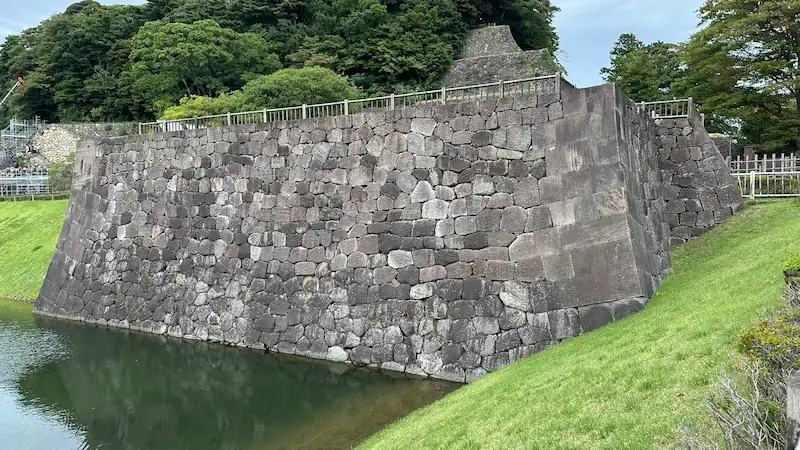
The massive stonework projecting into the eastern tip of Imori-bori (Imori Moat) is the Rikō Turret Platform. Despite the name, no definitive record confirms a turret atop it; rather, it likely functioned as an outwork-like stone platform thrusting in an L-shape into the moat. Development accelerated after the great fire of 1631 (Kan’ei 8), and a 1664 (Kanbun 4) renovation refined it into a well-ordered coursed-rubble wall of Tomuro stone. Rising about eight ken (approx. 14.4 m) from the moat bed, it eliminated blind spots and shored up defenses toward Kurahashi Gate and Gyokuseninmaru—guarding the castle’s “throat.”
In 1907 (Meiji 40), its upper portion was shaved down and the moat was filled. Heisei-era surveys later revealed excellent preservation, leading to a 2008–2010 restoration using around 900 stones, including about 250 excavated originals. The contrast between the refilled, watered moat and the pale stone face is striking. From the era of Toshiie and Matsu onward, Kaga’s castle-building matured across generations, and the stonework here eloquently tells that story.
Panorama
| Construction Period | Early Edo (post-Kan’ei era) development; renovated in Kanbun 4 (1664) |
|---|---|
| Builders | Kaga Domain, Maeda clan (stonewall renovations by Goto Gonnobei and other stonework teams) |
| Structure & Features | L-shaped stone platform projecting into Imori-bori; roughly processed coursed masonry (Tomuro stone); approx. 14.4 m from moat bed |
| Alterations & Restoration | Upper shaved and moat filled in 1907 (Meiji 40) → excavations in the 2000s → 2008–2010 restoration with ~900 stones (incl. ~250 excavated) |
| Current Status | Restored stone wall open to the public (moat water also reinstated) |
| Loss & Damage | Upper structures lost in Meiji era (no conclusive proof of a turret having stood here) |
| Cultural Status | No individual designation; part of the nationally designated Historic Site “Kanazawa Castle Ruins” |
| Notes | Praised for exquisitely worked corners (e.g., Edo-style cutting) |
🗺 Address: 1-1 Marunouchi, Kanazawa (eastern end of Imori-bori in Kanazawa Castle Park)
🚶 Access
About a 9-minute walk from the previous spot, Nezumitamon Bridge.
⏳ Time Needed
Quick look: about 5 minutes
Leisurely visit: about 15 minutes (to appreciate the moat reflections and fine stonework)
📍 Highlights
- A dramatic overhang: The L-shaped projection cuts into the moat, erasing dead angles—a pinnacle of functional beauty.
- Stonecutters’ craft: Sharply worked corners and even joints showcase Kaga’s advanced stonewall techniques up close.
- Mirror-like water scenes: The restored moat reflects the pale stone; sunsets and illumination periods are especially photogenic.
- Seasonal appeal: Fresh greens and autumn foliage, plus winter’s snow drape, reveal striking stone-and-shadow contrasts.
📌 Trivia
- The “carp’s throat” nickname: The jutting form may have evoked a carp’s throat; the precise origin is unknown.
- Authentic restoration: About 250 excavated stones were reused, supplemented with new Tomuro stone of the same type.
- From Toshiie onward: Castle-building that began under Maeda Toshiie matured under his descendants, with stonework reaching a zenith in the Edo period.
Ōtemon Gate Ruins (Ōtemon Ato)
⭐ Recommendation
Historical Significance: ☆☆
Visual Appeal: ☆
Experiential Value: ☆
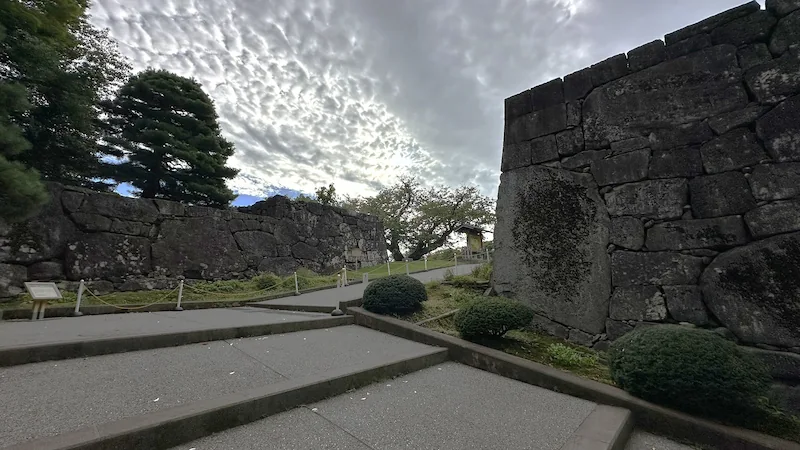
The Ōtemon Gate Ruins mark the site of Kanazawa Castle’s principal gate and the starting point of a grand entrance route featuring one of the largest box-shaped (masugata) gate complexes in the castle. The original Ōtemon stood near the Nishichōguchi during the period of Sakuma Morimasa, but under Maeda Toshiie it was shifted to the present “Osaka-guchi.” Today, no buildings remain; what you see is the preserved space of the “gate site” with stone walls and turret platforms.
Panorama
| Era & Development | Nishichōguchi phase (Tenshō era) → Relocated to Osaka-guchi shortly after Maeda Toshiie entered the domain (late 16th century) |
|---|---|
| Structure & Features | Large masugata (box-shaped) entrance with turret platforms; only stonework survives today. |
| Alterations | After cycles of construction, fires, and removal, the buildings are gone; stone walls are under preservation and maintenance. |
| Current Status | No gate or turrets; stone walls and turret bases remain visible. |
| Cultural Status | Protected as part of the nationally designated Historic Site “Kanazawa Castle Ruins.” |
| Notes | Once served as the castle’s main entrance, forming a triad with Ishikawa Gate and Hashizume-mon Gate. |
🗺 Address: Approx. 2-26 Ōte-machi, Kanazawa, Ishikawa
🚶 Access
Located along the outer “Ōte-bori” moat on a northbound castle-walk route. About a 10-minute walk from the “Kenrokuen-shita” bus stop.
⏳ Time Needed
Quick look: about 5 minutes
Leisurely visit: about 20 minutes
📍 Highlights
- Masugata defensive layout: The angled, non-straight approach reveals the ingenuity of the defense plan, readable in the surviving stonework.
- Massive turret bases: Among the castle’s largest surviving stone platforms—an object lesson in the scale and skill of Edo-period fortification.
- Imagine the procession: Though tranquil today, envisioning the route by which one entered the castle adds depth to your Sengoku and Edo-era exploration.
📌 Trivia
- When Ōtemon meant “main gate”: Unlike today—when Ishikawa Gate or Hashizume-mon often serve as principal entrances—this site was historically the castle’s face.
- Masons’ marks: Many stones bear chiselled symbols, evidence of multiple stonecutter guilds working on the project.
- Moat changes: The former “Ōte-bori” in front of the gate has been filled; imagine it as a water moat in its day.
Kuromon (Kuro-mon)
⭐ Recommendation
Historical Significance: ☆☆
Visual Appeal: ☆
Experiential Value: ☆
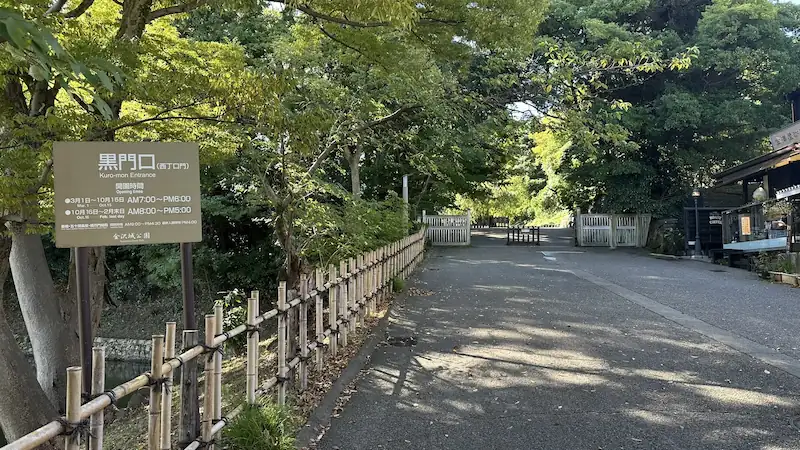
Kanazawa Castle’s Kuromon lies on the northwest side at what used to be the Ōte (main) approach called the “Nishichōguchi Gate.” In the era when the site was still the temple-fortress “Kanazawa Goshūdō,” this was its entrance. Later lords used this gate to enter and leave the castle.
Known as “Nishichōguchi Gate” in the Edo period, it gradually came to be called “Kuromon” (Black Gate) after the Meiji era. The gate buildings no longer survive; instead, the entrance remains and pathway—remembered as “Kuromon-guchi”—have been maintained as a symbolic waypoint for walkers.
Panorama
| Location & Origins | Main approach during the Kanazawa Goshūdō (temple-fortress) period (mid-16th c. onward) → In the Kaga Domain era, the primary entrance shifted elsewhere and this became a secondary gate. |
|---|---|
| Name Changes | “Nishichōguchi Gate” → “Kuromon” after the Meiji era |
| Structure & Features | No standing gate; you can view the gate site, path, stonework, and terrain adjoining the Ōte-bori moat. |
| Current Status | No gate buildings; the grounds and path are maintained and open as “Kuromon-guchi.” |
| Cultural Status | Protected as part of the nationally designated Historic Site “Kanazawa Castle Ruins.” |
| Notes | Nearby “Kuromonmae Green Space” offers cherry blossoms and examples of late-Edo to modern architecture. |
🗺 Address: Marunouchi, Kanazawa (west side of Ōte-bori)
🚶 Access
Reachable from the path along the castle’s Ōte-bori. About a 10-minute walk from the “Kenrokuen-shita” or “Minami-machi” bus stops. The “Kuromonmae Green Space” is nearby.
⏳ Time Needed
Quick look: about 3 minutes
Unhurried stop: about 10 minutes
📍 Highlights
- Traces of the early main gate: As the principal entrance when the site transitioned from temple to castle, this point reflects the castle’s formative stage.
- Path facing the Ōte-bori: From the gate site, look toward the moat to sense one of the castle’s defensive axes.
- Link to the castle town: A convenient approach from the Ōmichō Market / Musashigatsuji area—ideal as a starting point for sightseeing.
- Adjacent cherry blossoms: In spring, pair your visit with the cherry-lined Kuromonmae Green Space for history plus seasonal charm.
📌 Trivia
- Why the name “Kuromon”?: One theory ties the Meiji-era nickname to the dark tone of the gate or walls.
- Go-hime connections: Near Kuromonmae Green Space are remains associated with Go-hime, the fourth daughter of Maeda Toshiie—another thread for history buffs.
- A practical trailhead: Many guides propose starting at “Kuromon-guchi” and proceeding along the castle’s southern side—handy for first-time visitors.
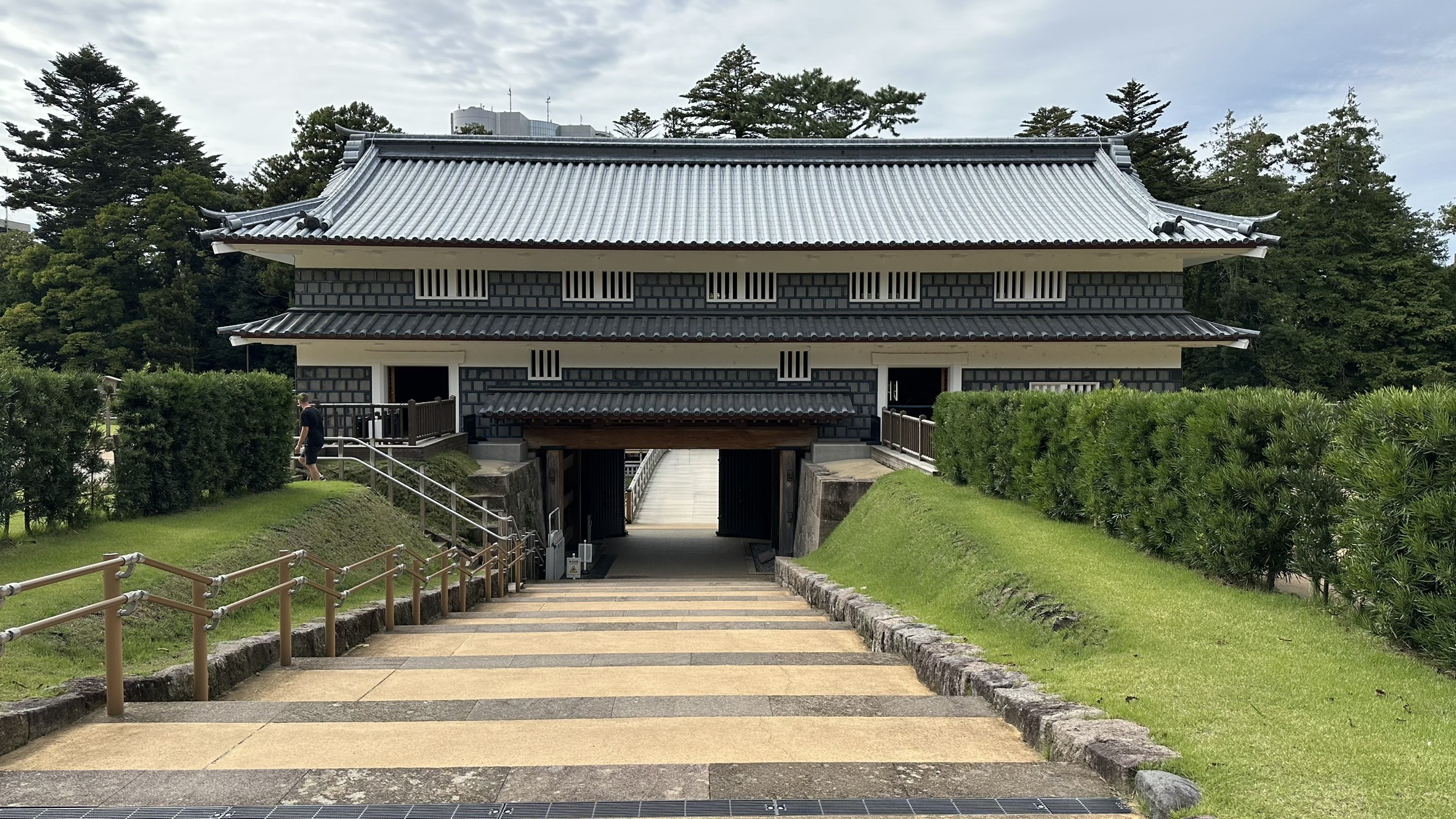


comment